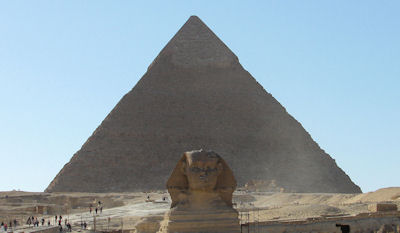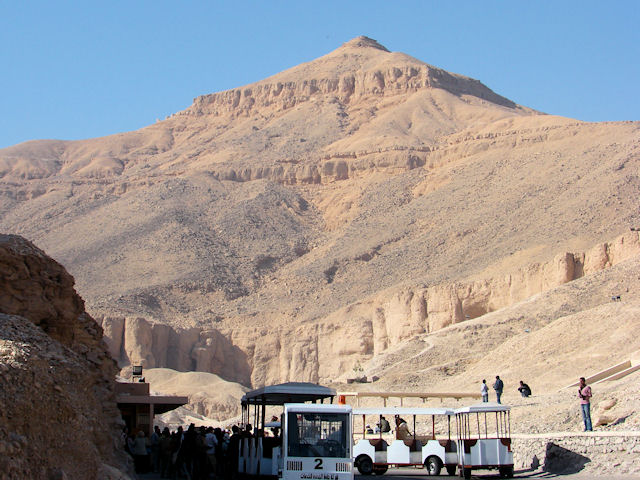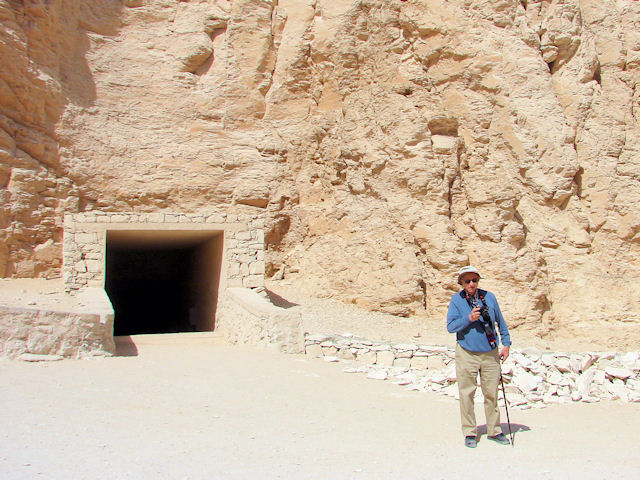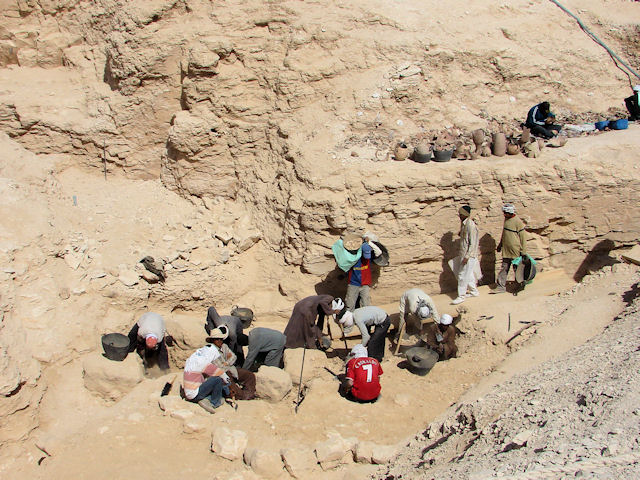

Pharaoh's
Island was fortified during the Crusades by Baldwin I, for use as a
control point in the Gulf of Aqaba, as protection for St. Catherine;s
and as a place to collect taxes. Saladin conquered the island,
and it is his fortifications that have largely been rebuilt.
Prior inhabitants have included Hiram, King of Tyre (~950 BCE). | |
Our
last taste of the Red Sea came in Hurghada. This is a seafront
town that seems to be in the midst of a building boom. The
colorful facades resemble the facades in at least one other Egyptian
seafront town, Taba Heights on the Gulf of Aqaba. | |
While
in Hurghada, we had the waterfront access offered by the Hilton
Hurghada Plaza Hotel. All the usual beach stuff, like thatched
shelters and sand. However, the most striking single thing was
the 200-foot tunnel of bougainvilleas, seen at the left. Clearly a beautiful hotel.
| |
From
Hurghada, we crossed Egypt's mountainous Arabian Desert. Near the
peak, at a snack and fuel stop, we found this woman, her goat and
donkey. Actually, the goat fell off once during our 20-minute stop, but its balance and
dancing were pretty good. | |
After
traveling for hours through absolute aridity, one starts to understand
what a miracle the Nile really is. The Arabian Desert is behind
us, but there is more desert in view. There is a very narrow
green ribbon running through this very large nation. And 99% of the people live within the green ribbon. | |
Our hotel in Luxor was the Sofitel Winter Palace. The green theme of the Nile is echoed in the hotel gardens.
Why "Winter Palace?" The original buildings and gardens
were used by the Kings of Egypt as a palace in the upper reaches of the
Nile. King Farouk slept here! | |
Just
yards from the Winter Palace, you come to the Luxor Temple. It
was largely built by Amenhotep III (~1370 BCE) and Ramses II (~1250
BCE). | |
Abu'l
Haggag lived in Luxor for about 50 years before his death in 1243 CE,
and he is regarded as the patron saint of Luxor. While the Abu'l
Haggag Mosque
we see here was built in the 19th century, the minaret was probably in
place when Abu'l Haggag arrived in town. This mosque is within the footprint of Luxor Temple, but its ground floor is about 30 feet above the floor of the Temple. That is the result of 2000 years of silting before the first mosque was built on the site. | |
Our
main visit to Luxor Temple was at night. Looking north , we see the
Avenue of the Sphinxes. In "the day," this avenue of statues
reached all the way from Luxor Temple to Karnak Temple, a distance of
about 2 miles, populated with 2000 sphinxes. Actually, this
avenue was constructed about a centuries after the two temples. | |
The
massive First Pylons of Luxor Temple lead into the court of Ramses II.
The entry is flanked by two remaining colossi of Ramses II.
The obelisk is the twin of Cleopatra's Needle, which was moved
from its position here to Place de la Concorde in 1826, as a gift from
Ali Muhammed to King Louis-Phillipe. | |
This is the court of Ramses II, and you can see why he is known for his modesty. | |
The highest points in Luxor Temple are the columns that form the colonnade of Amenhotep III. | |
 | On
the western side of the Nile, the side devoted to the dead, we visited
the Valley of the Kings. This was where the pharaohs of the New
Kingdom were buried, and many royal family members were buried here as
well. The Valley of the Kings is remarkably un-photogenic, in
large part because the pharaohs of the New Kingdom wanted to keep their
grave sites secret. With the exception of King Tut's tomb,
discovered in 1922, the other 63 tombs here were looted long before the
modern era. That is what happens when tomb builders moonlight as tomb robbers. |
 | Photography
was not allowed inside the tombs, but the outer facades (modern, of
course) are not much to see. This opening leads to the burial
chambers of a pharaoh. Our traveling companion, Donald, is
standing out front. |
 | The
Valley of the Kings continues to be a very active archaeological site.
Here we see excavation in KV64, a tomb discovered in 2008.
And there is a KV65, yet to be excavated. Everyone hopes
for another King Tut situation. Tut was a very minor pharaoh, but
the treasures from his tomb fill an entire floor of the Egyptian Museum
in Cairo. |
The
Avenue of the Sphinxes, this time at Karnak. Karnak Temple and Luxor
Temple were in the city of Thebes, which was the capital of Egypt from
about 2100 BCE until around 1400 BCE. | |
These pylons mark the entrance to the Precinct of Amun Re, one of three huge complexes forming Karnak Temple. | |
This is the other side of the pylons above, and they are not finished. This pile of mud bricks was once the
scaffolding used to build up the wall. Afterward, it would have
been finished from the top downward, tearing down the mud brick ramps
as the workmen completed the decoration of each plateau. | |
This
is a hint at the Hypostyle Hall in Karnak Temple. It is made up
of 134 columns in 16 rows. They are at least 10 feet in diameter,
and about 35 feet tall, except for the twelve that are 65 feet tall. | |
This
obelisk was erected by Hatshepsut, a unique pharaoh. She was the
sole female pharaoh, a fact that subsequent pharaohs tried to suppress. | |
The
central halls of the Precinct of Amun Re, which are a small fraction of
the whole precinct. There is even a good size lake. | |
The
regions of Saqqara and Giza lie at the edge of the desert, west of
Cairo. This region became the burial grounds for the pharaohs and
other nobles of the Old Kingdom. This is a mastaba, the
style of tomb that predated the pyramids. Mereruka, the one-time occupant of this mastabe, was vizier to
the Pharaoh Teti, and his tomb has 32 decorated rooms. | |
The
first pyramid was the step pyramid of Zoser, designed and built by
Imhotep around 2600 BCE. The idea was a stack of masatabas, one
on top of the other. | |
Not too long after Zoser's Step Pyramid, the pharaoh Sneferu
undertook the construction of a non-step pyramid. The sides
started out too steeply, and the angle had to be changed to avoid
disaster. Sneferu made another try, and defined the contours that
we all know as Egyptian pyramids. It looks like a masataba tomb
in the foreground. | |
The
pyramids of Giza include the Great Pyramid of Khufu on the left, which
is actually larger than the "White Pyramid" built by his son Khafre on
the right. These pyramids were built around 2500 BCE. Ramses
II had his temple builders harvest some of the limestone casing from
these pyramids to build one of his temples. That would have been
around 1250 BCE. | |
The
sphinx is part of Khafre's overall burial complex, with a carefully
graded causeway running from the sphinx and temples below to the tomb
(pyramid) above. | |
Camels are everywhere, Israel, Jordan, Sinai, Egyptian deserts and here on a road near the site of ancient Memphis (suburban Cairo). And take a closer look at the guy on the lead camel. Yes, cell phones were everywhere, too. The Sinai Bedouins had them; the Wadi Rum Bedouins had them, and everyone else, too. In the Sinai, the cell phone towers were solar powered, of course. | |
Here
is the Nile in Cairo, with the Ramses Hilton Hotel on the right. We stayed at the Ramses Hilton. | |
Saladin
built a citadel on the eastern boundary of Cairo, and this is the view
of the Khafre and Khufu pyramids on Giza. The proximity of modern
Cairo and these pyramids is sort of surprising. | |
The
Alabaster Mosque is located within the confines of the citadel.
This mosque houses the tomb of Ali Muhammed, the first modern
king of Egypt. He started its construction in 1830, and the style
came from the Ottoman Turks. | |
To me, the interior of the Alabaster Mosque is at least as pretty as the Blue Mosque in Istanbul. | |
This scene in central Cairo shows a lot of typical Cairo.
First, note that the traffic is grid-locked in the vicinity of the
green sign. There are merchants spilling all over the sidewalk
and street. Pedestrians cross where there is a real or
prospective gap between vehicles. I tried crossing some Cairo streets, and it is clearly an acquired skill. |
| Return to Home Page | Navigate to Previous Page |